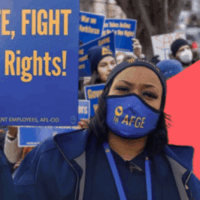Nationwide—In August, the U.S. economy gained 187,000 jobs and the unemployment rate rose to 3.8% according to new data from the Bureau of Labor Statistics. The unemployment rate for Black workers was 5.3%, and the rate was 3.4% for white workers, 3.1% for Asian workers, and 4.9% for Latinx workers. Continuing disparities in unemployment rates are a result of structural racism in the U.S. labor market.
“It’s good news when the national unemployment rate remains near record lows,” said Rebecca Dixon, president and CEO of the National Employment Law Project. “It’s also an opportunity to think about the workers who aren’t counted as unemployed. The 3.8% unemployment rate doesn’t count people who want a job but aren’t actively searching for work, or part-time workers who want a full-time job but can’t find one. It also doesn’t include the nearly 2 million people in prisons and jails across the U.S. Many incarcerated people are working during their sentences, but their labor doesn’t qualify them for unemployment benefits when they return to the community and are looking for work. We need to build an economy that respects and supports all workers.”
In August, 6.4 million workers were unemployed. An additional 5.5 million workers were out of work and wanted a job but were not counted as unemployed because they were not currently searching for work. Among them were 364,000 “discouraged workers,” who reported that they were not currently seeking work specifically because they believed no jobs were available for them or there were no jobs for which they would qualify. The numbers of discouraged workers and workers marginally attached to the labor force have declined since 2020 as the economy continues to add jobs.
There were 4.2 million workers who worked part-time in August but would have preferred full-time employment. This includes workers who worked part-time because their hours had been reduced or they were unable to find full-time jobs. It does not include part-time workers who preferred part-time employment. Black and Latinx men were disproportionately more likely to be employed part-time despite preferring full-time employment.
The Bureau of Labor Statistics calculates that if all jobless workers who wanted a job and all part-time workers who wanted full-time work were counted alongside unemployed workers, the unemployment rate for August 2023 would be 7.1% rather than 3.8%.
Yet this statistic still does not account for incarcerated people, who are not counted as part of the U.S. labor force even though 2 out of 3 work during their incarceration. The U.S. criminal legal system is marked by deep racial disparities that cannot be explained away by greater offense rates. As a result of systemic racism in policing, charging, and sentencing, Black men are 6 times as likely to be incarcerated as white men and Latinx men are 2.5 times as likely. One result is to fuel cycles of unemployment among workers of color, as an estimated 60% of people who have been incarcerated remain jobless a year after release. Studies suggest that workers with arrest and conviction records are also overrepresented among discouraged workers and part-time workers who would prefer full-time employment.
Policymakers must work to deliver economic justice and repair for incarcerated workers and people with arrest and conviction records. One promising proposal is New York’s Unemployment Bridge Program. If enacted, the policy would extend benefits to some workers seeking employment after release from incarceration. For a deeper look at the ways criminalization locks workers into cycles of unemployment and sub-standard work as well as a policy agenda to address criminalization in the labor market, see Worker Power in the Carceral State, by NELP Senior Staff Attorney Han Lu.
At the same time, policymakers must act to build an unemployment insurance system that will support all workers at all times. This includes establishing minimum federal standards for UI eligibility, benefit duration, and benefit adequacy that all state unemployment systems must meet; ensuring equitable access to UI benefits; modernizing and reforming the Extended Benefits program; and establishing additional emergency UI programs that automatically trigger on during periods of high unemployment. This also includes adequate and sustained funding for UI administration, oversight, and IT modernization, which is essential to ensure timely and accurate payments. A transformed unemployment insurance system will strengthen the economy and enable all workers to thrive.



